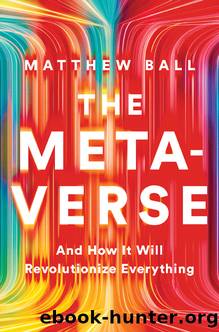The Metaverse: And How It Will Revolutionize Everything by Matthew Ball

Author:Matthew Ball [Ball, Matthew]
Language: eng
Format: epub
Tags: Social Science, Philosophy & Social Aspects, History, Social Aspects, Technology & Engineering, Epub3, Science, Technology Studies
ISBN: 9781324092049
Google: pdZKEAAAQBAJ
Publisher: Liveright
Published: 2022-07-19T20:46:05+00:00
The 30% Standard
We might assume that the virtual world would have âbetterâ payment rails than the âreal world.â After all, its economy primarily involves goods that only exist virtually, and that are bought via purely digital (and thus low marginal cost) transactions, and are, for the most part, $5â$100 each. The virtual economy is also large. In 2021, consumers spent more than $50 billion on digital-only video games (in contrast to physical discs), and nearly $100 billion more on in-game goods, outfits, and extra lives. As a point of comparison, $40 billion was spent at the theatrical film box office in 2019, the last year before the COVID-19 pandemic, and $30 billion on recorded music. Whatâs more, the âGDPâ of the virtual world is growing rapidlyâit has quintupled on an inflation-adjusted basis since 2005. In theory, these facts should mean creativity, innovation, and competition in payments. In practice, the reverse has been true; the payment rails of todayâs virtual economy are more expensive, cumbersome, slow to change, and less competitive than those in the real world. Why? Because what we consider to be a virtual payment rail, such as PlayStationâs wallet, Appleâs Apple Pay, or in-app payment services, are really a stack of different âreal worldâ rails and forced bundle of many other services.
In 1983, the arcade manufacturer Namco approached Nintendo about publishing versions of its titles, such as Pac-Man, on its Nintendo Entertainment System (NES). At the time, the NES was not intended to be a platform. Instead, it played only titles made by Nintendo. Eventually, Namco agreed to pay Nintendo a 10% licensing fee on all of its titles that appeared for NES (Nintendo would have right of approval over every individual title), plus another 20% for Nintendo to manufacture Namcoâs game cartridges. This 30% fee ultimately became an industry standard, replicated by the likes of Atari, Sega, and PlayStation.2
Forty years later, few people play Pac-Man anymore, and costly cartridges have transformed into low-cost digital discs manufactured by game-makers and even lower-cost bandwidth for digital downloads (where the costs are mostly borne by consumers via internet fees and console hard drives). However, the 30% standard has endured and expanded to all in-game purchases, such as an extra life, digital backpack, premium pass, subscription, update, and more (this fee also covers the two to three percentage points charged by an underlying payment rail, such as PayPal or Visa).
Console platforms have several rationales for the fee beyond simply making money. The most important is how they enable game developers themselves to make money. For example, Sony and Microsoft typically sell their respective PlayStation and Xbox consoles for less than they cost to manufacture, which makes it cheaper for consumers to access powerful GPUs and CPUs, as well as other related hardware and components that are needed to play a game. And this per-unit loss is before these platforms allocate the research and development investments to design their consoles, marketing costs to convince users to buy them, and exclusive content (that
Download
This site does not store any files on its server. We only index and link to content provided by other sites. Please contact the content providers to delete copyright contents if any and email us, we'll remove relevant links or contents immediately.
Mastering Bitcoin: Programming the Open Blockchain by Andreas M. Antonopoulos(2980)
Dawn of the New Everything by Jaron Lanier(2737)
Blockchain: Ultimate Step By Step Guide To Understanding Blockchain Technology, Bitcoin Creation, and the future of Money (Novice to Expert) by Keizer Söze(2444)
Alibaba by Duncan Clark(2037)
Foundations of Blockchain by Koshik Raj(1945)
Owning Bitcoin: The Illustrated Guide to Security, Privacy, and Potential by Apodaca Richard(1933)
Significant Zero by Walt Williams(1927)
The Mastermind by Evan Ratliff(1898)
Mastering Blockchain by Imran Bashir(1832)
Bitcoin: The Basics of Blockchain and Investing in Cryptocurrency by K. Connors(1781)
Bitcoin: The Ultimate Guide to the World of Bitcoin, Bitcoin Mining, Bitcoin Investing, Blockchain Technology, Cryptocurrency (2nd Edition) by Ikuya Takashima(1664)
Attack of the 50 Foot Blockchain by David Gerard(1654)
Turing's Cathedral by George Dyson(1630)
The Bitcoin Standard: The Decentralized Alternative to Central Banking by Saifedean Ammous(1630)
Cryptocurrency by Neil Hoffman(1607)
Shaping the Fourth Industrial Revolution by Klaus Schwab & Nicholas Davis & Satya Nadella(1597)
The Bitcoin Guidebook by Ian DeMartino(1577)
Dawn of the New Everything: Encounters with Reality and Virtual Reality by Jaron Lanier(1577)
Bill Gates by Michael Becraft(1534)
